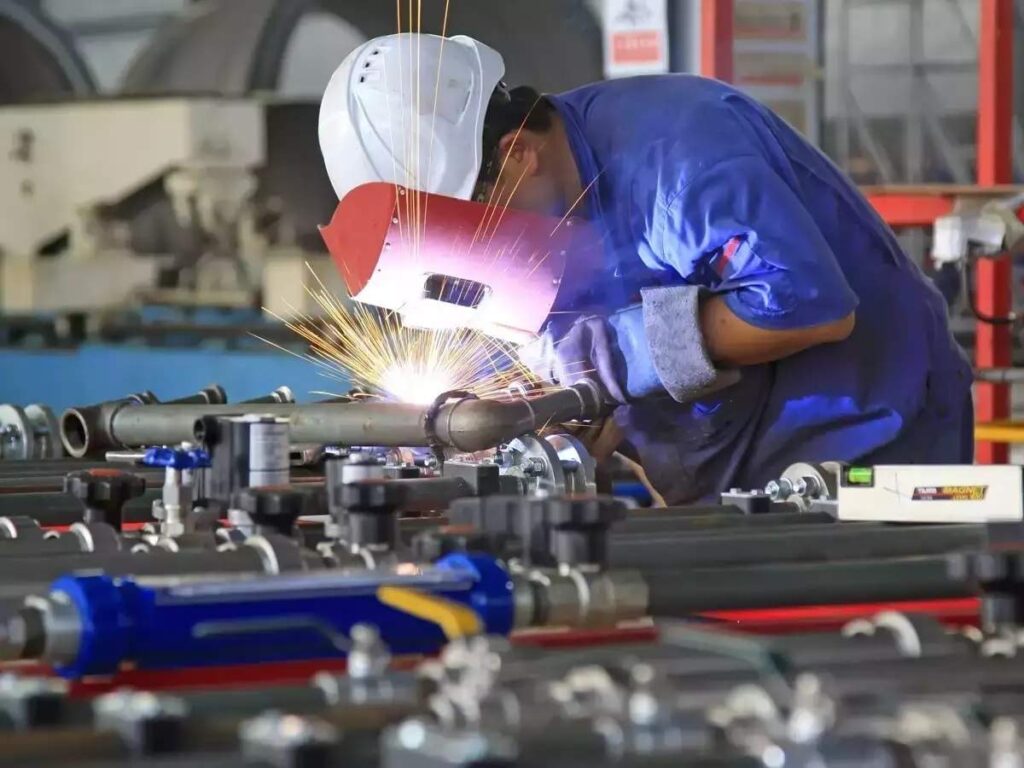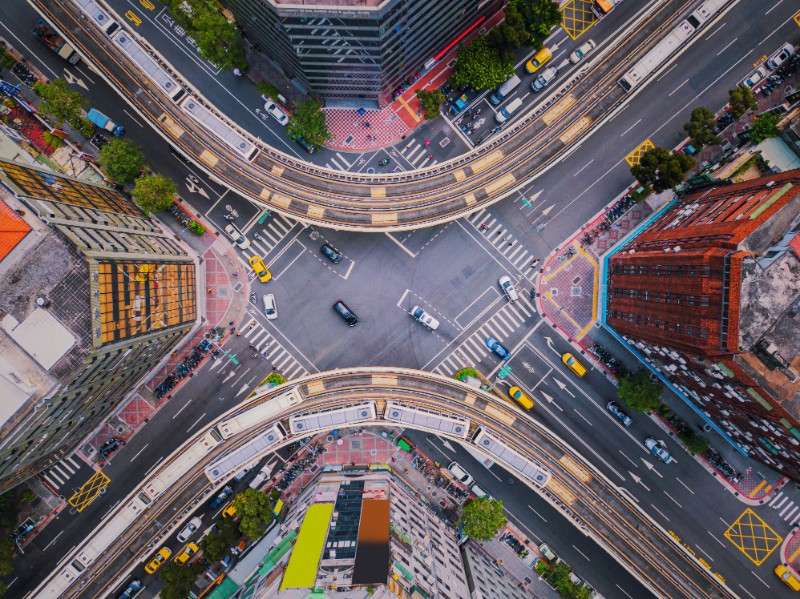Construction industry: Various sectors have been affected differently by the pandemic, and some have a more optimistic outlook than others. The pandemic initially hampered the growth of the otherwise thriving construction and real estate sectors. However, the industry quickly recovered in the second half of 2020. Despite supply chain challenges, migrant labor shortages, and liquidity constraints, new opportunities in emerging sectors have reenergized investors. Different industries have affected differently, and some have a more optimistic outlook than others. Though reaching preCOVID stats is a long-term goal, the slow recovery is encouraging.
Commercial sector

The COVID-19 has undoubtedly brought a new perspective to Construction industry workspaces as we know them. The spaces were ideal for collaboration, but as times change, more emphasis put on location, experience, convenience, functionality, and well-being.
Bangalore and Hyderabad are on the mend, accounting for nearly 47 percent of total leasing activity so far this year. Global investors are keen on Bangalore, and with the improving metro, infrastructure for flexible workspaces may make a comeback. Hyderabad reported to have accounted for approximately 3.7 million square feet of gross absorption year to date in the third quarter of 2020.
It is expected that Construction industry will continue to attract investors, primarily technology behemoths who have already entered the market and contributed to the country’s economic development. However, in light of the pandemic and the nearly 10-month remote working period, employers’ and employees’ attitudes toward commercial spaces have shifted, with a renewed emphasis on the well-being of employees and the flexibility provided to them.
Additionally, it is important to realize that working from home will not be a long-term solution. Employees must collaborate, and it is a basic human characteristic. Reduced seating with greater per-seat area allocation, a greater number of collaboration spaces, larger than before, and more open plan open area designs are likely to be the new trend for future workspace design. Large individual campus development will take place, with critical staff accommodation facilities actively planned.
Residential sector

Construction industry Residential sales in the top seven cities have, understandably, not yet reached pre-COVID levels. Mumbai, on the other hand, is seeing increased sales as a result of Maharashtra’s stamp duty reduction. According to a PropEquity report, sales in India’s top seven cities increased by 20% in October 2020 compared to September 2020, but remain lower than sales in October 2019.
According to an Anarock report, Hyderabad, Kolkata, and NCR recovered and exceeded launches in the third quarter compared to Q12020, while Mumbai and Bengaluru recovered nearly 75 percent and 68 percent, respectively. There are a large number of stalled projects in the top seven cities, totaling approximately 4000 billion INR. Many of the above have not been able to meet the 2020 completion date, despite the fact that work began as early as 2013.
Buyers now prefer more spacious homes and not necessarily in the tier 1 cities, a shift from before. The waive off on GST for ready-to-move-in properties and GST slashes on affordable and regular units motivate buyers. After the RBI announced several rate cuts, bringing the repo rate down to 4%, and its positive effect on buyer sentiment would only manifest in the medium to long term. This step could be considerable support for existing buyers, who might struggle to pay EMIs in the short-term or medium-term, because of the lockdown or in the event of job loss.
There is also a land tax that the government should consider. A 33 percent down payment on land, particularly in cities where the cost of land is quite high, can be quite discouraging to a buyer. Policy changes towards the significantly high land taxes would put the buyers at ease.
Other government initiatives, such as affordable housing for all by 2022, may be the ‘light at the end of the tunnel’ for some developers, as this market is currently viewed as the future of the residential sector. With the luxury market already overstressed, mid-luxury developers are looking to expand into this market.
Delhi and Mumbai are the two regions that are leading in the affordable housing sector followed by Pune and Chennai. Another segment that can reshape the future of the residential sector is Senior citizen living spaces, the importance of which has been noticed during the pandemic, where the country was in lockdown and the lack of domestic help and the inability to use technology to fend for the day-to-day needs, was not a hassle in such living spaces.
Hospitality sector

The hospitality sectors have been the most affected in the last three quarters of 2020 an effect of the COVID-19 lingers on into the next few quarters as well. The sector, however, refusing to give up, has opened up some of its hospitality sections such as hotels and resorts with new safety measures and has managed to gain consumer confidence, promoting stay in hotels and resorts.
Hope for the sector has risen with people travelling domestically to escape the long confinement in their homes possibly willing to spend on their first flight or a nice holiday. This surge was portrayed immediately after the lockdown lift, holiday season and end of the year. The growth trajectory of Construction industry might rise once the vaccine and the vaccination across the country take place.
International travelers should stay away for a while due to global travel restrictions. Apart from this, stand-alone and private villas in the driveable distance from major metros have seen a considerable uptick in the demand which may trigger extended villa developments in near future.
Despite the current state of demand, it may take some time for the sector to stabilize even with government support. The need for liquidity and policy support is very much required as noted by the Federation of Hotel & Restaurant Associations of India (FHRAI) and National Restaurant Association of India (NRAI). The sector now seems to need a serious restructuring for its future survival with situations such as the pandemic in view, whether it be merging of assets or renovating to make it more competitive for the local/international crowds. The Government has assigned the RBI to look into the financial support that the Government can offer this Construction industry.
Retail sector

Retailers in India expect to reach 85% of pre-pandemic sales in fashion, electronics, and groceries in the next six months. However, a lack of international travelers to escape the winter has placed pressure on the sector. Until the vaccine is fully rolled out and safety becomes a concern, retail sales have yet to increase. In November, the consumer durables and electronics category continued to recover with sales at 12% year-on-year.
5% sales growth for groceries has occurred and about -12% growth for apparel and clothing since pre-pandemic. The retail Construction industry digital market has surged over the last year and continues on.
While brick and mortar are yet to revive, the truth of which will be known following the complete solution to the pandemic situation, e-commerce is thriving on this very situation and has now had a good foothold for its future growth.
Like the hospitality industry the retail industry has also reached out to the Government to aid the sector which employs over 46 million and is one of the largest contributors to the Indian GDP sizing to about $854 billion as per the RAI.
Healthcare sector

The IBEF projects that the health care system will grow three-fold by 2022 to INR 8.6 trillion. The gross domestic product (GDP) of the country is showing substantial growth prospects in the health care sector. The Government’s expenditure on healthcare sector has grown to 1.6% of the GDP in FY20BE from 1.3% in FY16.
Health insurance is gaining a large momentum in India. Gross direct premium income underwritten by health insurance grew 17.16% y-o-y to Rs. 51,637.84 crore (US$ 7.39 billion) in FY20. The National Telemedicine platform proactively use by doctors to consult with patients remotely since its inception.
The number of medical colleges have increased to more than 560 from just 412 in FY16 which is substantial. Medical tourism has also become a big part of India’s growing research and development sector, which has attracted foreign investors. India’s health sector spends 1.6% of its GDP, compared to other countries’ 8.8%. According to an IMF report, high and low skilled jobs in the health sector could increase GDP.
The construction sector is looking very promising with the hospital industry in India forecasted to increase to Rs. 8.6 trillion (US$ 132.84 billion) by FY22 from Rs. 4 trillion (US$ 61.79 billion) in FY17 at a CAGR of 16–17%. The Government of India is planning to increase public health spending to 2.5% of the country’s GDP by 2025.
Pharmaceutical sector

The Union Cabinet has approved a change to the existing Foreign Direct Investment (FDI) policy in the pharmaceutical sector, allowing FDI up to 100 percent under the automatic route for the manufacture of medical devices subject to certain conditions.
Indian Institute of Technology (IIT) Bombay researchers increased research and development (R&D) during COVID-19 in November 2020. Increased R&D investments are likely to result in more investments in R&D facilities and manufacturing facilities.
There have also been government initiatives to improve the performance of the sector. India and the Netherlands intend to work together to provide digital health services and security to all citizens. The government announced a Rs. 15,000 crore (US$ 2.04 billion) production linked incentive (PLI) scheme for the pharmaceutical industry in September 2020.
According to the IBEF, India intends to establish a fund worth nearly Rs. 1 lakh crore (US$ 1.3 billion) to assist companies in manufacturing pharmaceutical ingredients in India by 2023. Rural healthcare programmes, life-saving drugs, and vaccines herald a period of good growth in the healthcare sector.
Data centres

The COVID-19 has certainly enhanced the IT side of the country. Many companies saw less disruption in past years when they invested in technology. With the well-being of employees the prime focus of any competitive company, flexibility of work from home and office are being explored, all of them will translating to the rise in need of cloud based data processing and storage, leading to exponential growth and interest in data centres and data security options.
Following on a rise in data consumption as much as 38% rise year-on-year for FY21 as well as data localization norms, this is one of the most watched and talked about sector, There are a projection of at least 28 hyperscale datacentres over the next three years, which will span over 16+ million sq. ft. with at least 1,400+ MW of IT power capacity as per a report from Anarock.
As of the first half of 2020, colocation has increased by about 8%, totaling 375MW. The growth of 1078MW forecast for the Construction industry by JLL for 2025, which translates to 9.3 million sqft. This is likely to raise interest in investors considering built to suit development for global cloud providers.
In response to the Digital India drive, all companies will revise their IT spending this year. Mumbai and Chennai remain cloud players’ preferred choices as their data centers grow fastest. Datacenter park’s reorganized digital infrastructure, and favorable policy push are key to this market’s growth. IT hub spots such as Pune, NCR, and Hyderabad will also continue to see increased demand.
Manufacturing sector

This industry has received plenty of support by the Government even before the onset of the COVID-19. The Make in India program brought this sector to the spotlight. This initiative is known to attract hi-technology manufacturing global giants to set up manufacturing.
The construction industry remains in good shape and the Government is trying to create more jobs. In terms of production, basic metals (10.8%), intermediate goods (8.8%), food products (2.7%), and tobacco products (2.9%) saw strong growth. India’s Index of eight core industries stood at 131.9 in FY20.
The manufacturing sector in India gained momentum in the second quarter of 2020, experiencing its strongest level in 13 years. According to the United Nations Conference on Trade and Development (UNCTAD), India ranked among the top 10 recipients of Foreign Direct Investment (FDI) in South Asia in 2019, attracting US$ 49 billion—a 16% increase from the previous year.
The growth of micro, small and medium enterprises (MSMEs) might pick up as the National Small Industries Corporation (NSIC) signed a Memorandum of Understanding (MoU) with Dun & Bradstreet Information Services India to create an ecosystem to encourage, finance and promote growth. The shift of supply chains from China to other economies gives India a chance to rebound from the pandemic’s effects. The absorb this new requirement, India should have policies and strategies to.
Samsung, Apple, Foxconn, Tesla are a few big names setting up production units in India and propelling this sector forward. The Government are also looking to encourage employment through the skill training for 3 lakh migrant workers provided by the Ministry of Skill Development and Entrepreneurship, from 116 districts across Uttar Pradesh, Bihar, Rajasthan, Odisha, Madhya Pradesh and Jharkhand which would be centrally controlled by the component of the Pradhan Mantri Kaushal Vikas Yojana (PMKVY) 2016-20.
Infrastructure

The potential for infrastructure is quite high, and the government has been eager to invest in such projects, particularly since the start of the COVID-19, with the National Highway Authorities of India awarding a record high of 744km length highway projects for the April to August 2020 period, valued at approximately INR 473 billion.
In recent months, tenders have been invited for projects such as the greenfield Delhi-Amritsar-Katra expressway, which is estimated to cost INR 8.40 billion, and a six-lane, access-controlled highway under the Bharatmala Pariyojana, which is estimated to cost INR 7.07 billion.
ALSO READ: Construction Price: A Look At Recent Trends
In Rajasthan, 68 development projects, mostly related to smart cities, worth approximately INR 13.31 billion, are set to begin. Mangaluru Smart City will be one of the first smart cities to go live in Karnataka. Mangaluru Smart City’s Integrated Command and Control Centers (ICCC) are already functioning as war rooms to combat terrorism.
The Rail Land Development Authority (RLDA), a statutory body under the Ministry of Railways, has begun work on redeveloping several railway stations across the Indian Railways network. They intend to build five railway stations in the state of Bihar. Among the cutting edge amenities will be restaurants, food plazas, cafes, WiFi, shopping areas, and medical emergency booths.
In the CFO’s view, infrastructure investments will reach $80-100 billion annually by 2023, with an increasing trend predicted.

